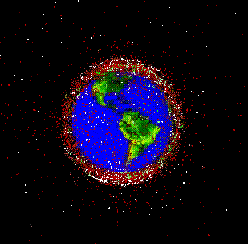
Orbital debris in the near-Earth space environment is made up of micrometeoroids and man-made debris. The man-made debris or space junk consists mainly of fragmented rocket bodies and spacecraft parts created by 40 years of space exploration. These objects number in the millions and orbit the earth at hypervelocities.
The orbital debris environment is growing. More satellites are being launched and with non-functioning satellite explosions and fragmentation, the threat of debris impact damage on satellites and spacecraft is a major concern. Orbital debris remains in orbit a long time, and high-speed collisions between existing particles can produce even more debris.
NASA's Extreme Ultraviolet Explorer (EUVE) re-entered the Earth's atmosphere at approximately 11:15 p.m. EST Wednesday. According to calculations made by the United States Space Command Space Control Center, EUVE re-entered the atmosphere over central Egypt.
"The actual location of EUVE's re-entry was within the predicted orbit track," said Scott Hull, spacecraft engineering lead for space science mission operations, at NASA Goddard Space Flight Center, Greenbelt, Md. "We expected EUVE could come in at a number of points along the ground track."
EUVE did not have an on-board propulsion system to allow engineers to control the spacecraft's re-entry. Using U.S. Space Command data, engineers calculated EUVE's orbit track and predicted where it could re-enter the atmosphere. EUVE was in a 28.5-degree orbit and could re-enter in any location within this orbit range. This range included areas as far north as Orlando, Fla., and as far south as Brisbane, Australia.
The object was not designed to survive re-entry intact and was expected to break apart and mostly burn up in the atmosphere. U.S. Space Command cannot confirm if any pieces survived re-entry.
Space Junk Danger : Satellite Falling to Earth
January 29, 2002 - Aging NASA Spacecraft to Reenter Earth's Atmosphere
 Engineers at NASA Goddard Space Flight Center in Greenbelt, Maryland predict a 7,000-pound spacecraft could re- enter the Earth's atmosphere as early as 10 p.m. EST on Jan. 30 or as late as 7 a.m. EST on Jan. 31.
Engineers at NASA Goddard Space Flight Center in Greenbelt, Maryland predict a 7,000-pound spacecraft could re- enter the Earth's atmosphere as early as 10 p.m. EST on Jan. 30 or as late as 7 a.m. EST on Jan. 31.
NASA's Extreme Ultraviolet Explorer (EUVE) is currently 200 kilometers (124 miles) above the Earth with a descent rate of 25 kilometers (15.5 miles) a day. The estimated debris field is expected to be 800 to 1,000 kilometers (500-625 miles).
"The probability of the few EUVE surviving pieces falling into a populated area and hurting someone is very small. It is more likely that the small pieces will fall into the ocean or fall harmlessly to the ground," said Ronald E. Mahmot, Project Manager for Space Science Mission Operations at Goddard.
Unlike the Compton Gamma Ray Observatory, which was safely de-orbited June 4, 2000, EUVE does not have an on-board propulsion system to allow engineers to control its re-entry. Much of EUVE will burn up in the atmosphere before ever reaching the ground. However, estimates show that up to nine objects ranging from approximately four to 100 pounds may survive re-entry. Much of this debris is made of titanium and stainless steel.
EUVE will start to break up when it falls to within 80 kilometers (50 miles) of the Earth. At this point, EUVE will have only four or five 90-minute orbits left before re- entering the Earth's atmosphere. Engineers will not know the re-entry point until approximately 12 hours prior to impact.
EUVE is in a 28.5-degree orbit and could re-enter in any location within this orbit range. This ranges includes areas as far north as Orlando, Fla., and as far south as Brisbane, Australia.
EUVE was launched on June 7, 1992. Science operations ended for the spacecraft in December 2001. During its early years, EUVE was operated from Goddard. In 1997, control of EUVE was transitioned from Goddard to the University of California, Berkeley and remained there until the program's termination in 2001. Slated for only three years, EUVE was operational for eight. NASA twice extended its scientific mission.
During its eight years in orbit, EUVE successfully opened a new window on the cosmos and helped to bridge the gap in our understanding of the extreme ultraviolet spectrum. Rather than seeing about 24 nearby objects as many predicted, EUVE observed more than 1,000 nearby sources, including more than three dozen objects outside our galaxy.